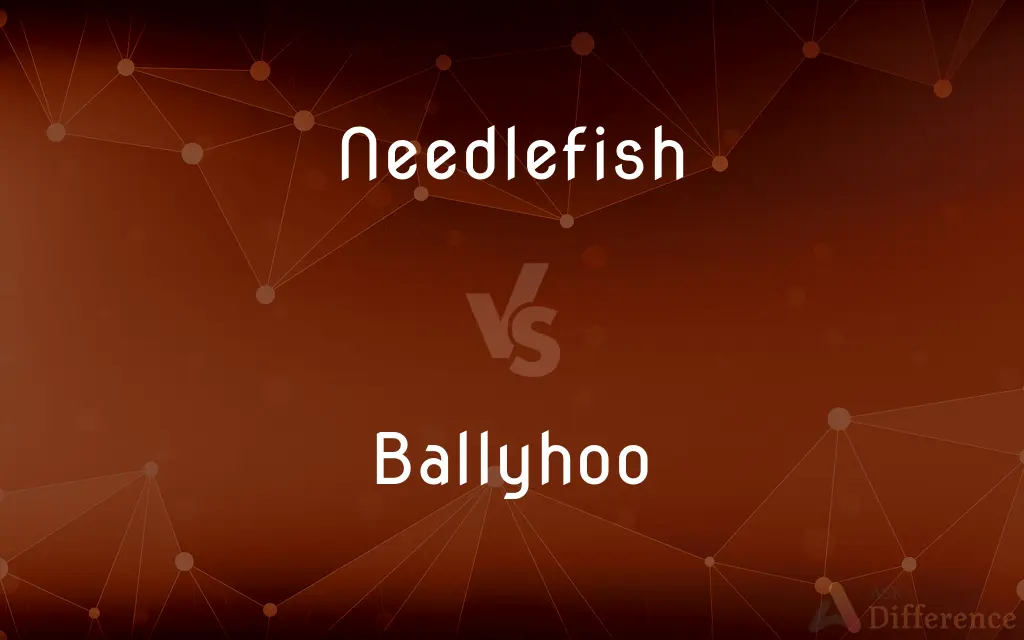Needlefish vs. Ballyhoo — What's the Difference?
Edited by Tayyaba Rehman — By Maham Liaqat — Updated on March 31, 2024
Needlefish are known for their slender, elongated bodies and sharp beaks, common in tropical and subtropical waters; ballyhoo, a type of needlefish, is prized as bait in sport fishing.

Difference Between Needlefish and Ballyhoo
Table of Contents
ADVERTISEMENT
Key Differences
Needlefish, belonging to the family Belonidae, are characterized by their long, slender bodies and elongated jaws filled with sharp teeth, adapted for surface dwelling and feeding in tropical and subtropical marine environments. Whereas ballyhoo, part of the halfbeak family Hemiramphidae and often associated with the needlefish due to their similar appearance, are specifically valued in sport fishing, especially as bait for larger game fish like marlin and tuna.
Needlefish are known for their powerful, streamlined bodies that enable them to make quick, darting movements in the water. They are often found in shallow coastal waters, seagrass beds, and around coral reefs. On the other hand, ballyhoo tend to inhabit similar environments but are more commonly associated with offshore areas, where they school near the surface and are frequently used by anglers to attract predatory fish.
In terms of behavior, needlefish are solitary or form small groups and are known for their ability to leap out of the water, sometimes leading to accidental injuries to humans and animals. Ballyhoo, however, are more often found in schools and are a preferred choice for live bait in fishing due to their ability to attract larger predators with their surface swimming and jumping behaviors.
When it comes to reproduction, both needlefish and ballyhoo lay eggs, but needlefish have a unique method of spawning where the eggs are attached to floating objects or seaweed via sticky filaments, ensuring their offspring's safety in open waters. Ballyhoo also lay eggs with adhesive properties but tend to spawn in shallower waters, where the eggs attach to seabed vegetation or coral.
Despite their differences, both species play important roles in their ecosystems as both predators and prey. Needlefish feed on smaller fish and crustaceans, while being targeted by larger fish, birds, and humans. Ballyhoo, while also feeding on small invertebrates and plankton, are highly sought after by sport fishers for their effectiveness as bait.
ADVERTISEMENT
Comparison Chart
Family
Belonidae
Hemiramphidae
Body Shape
Long and slender with both jaws elongated
Lower jaw significantly longer than the upper
Habitat
Tropical and subtropical waters, coastal regions
Similar, with a preference for offshore areas
Behavior
Solitary or small groups, known for leaping
Schooling, used as live bait in sport fishing
Reproduction
Eggs attach to floating objects or seaweed
Eggs attach to seabed vegetation or coral
Compare with Definitions
Needlefish
A slender, elongated fish with sharp beaks.
The needlefish skimmed the water's surface, hunting for its next meal.
Ballyhoo
A type of halfbeak used as bait in sport fishing.
Anglers prefer ballyhoo for baiting marlin.
Needlefish
Feeds on small fish and crustaceans.
The needlefish darted swiftly to catch a small shrimp.
Ballyhoo
Eggs attach to seabed vegetation for spawning.
Ballyhoo eggs were spotted attached to seagrass near the shore.
Needlefish
Predominantly found in tropical and subtropical waters.
Snorkelers often spot needlefish in the shallow coral reefs.
Ballyhoo
Known for its lower jaw protruding further than the upper.
The ballyhoo's distinct jawline makes it easily identifiable.
Needlefish
Capable of leaping out of water.
A startled needlefish leaped over the kayak, showcasing its agility.
Ballyhoo
Attracts larger predatory fish when used as bait.
The ballyhoo bait proved effective, attracting a large tuna.
Needlefish
Eggs have sticky filaments for attachment.
Needlefish eggs were found clinging to a piece of driftwood.
Ballyhoo
Often found in schools in offshore waters.
A school of ballyhoo jumped simultaneously, escaping a predator.
Needlefish
Needlefish (family Belonidae) or long toms are piscivorous fishes primarily associated with very shallow marine habitats or the surface of the open sea. Some genera include species found in marine, brackish, and freshwater environments (e.g., Strongylura), while a few genera are confined to freshwater rivers and streams, including Belonion, Potamorrhaphis, and Xenentodon.
Ballyhoo
The ballyhoo halfbeak or ballyhoo (Hemiramphus brasiliensis) is a baitfish of the halfbeak family (Hemiramphidae). It is similar to the Balao halfbeak (H. balao) in most features.
Needlefish
Any of various marine fishes of the family Belonidae, having slender bodies and long thin jaws with sharp teeth. Also called garfish.
Ballyhoo
Sensational or clamorous advertising or publicity.
Needlefish
Any of various other slender fishes, such as a pipefish or a sand lance.
Ballyhoo
Noisy shouting or uproar.
Needlefish
Slender fish, in the family Belonidae, usually found in shallow marine habitats.
Ballyhoo
A halfbeak (Hemiramphus brasiliensis) of the western Atlantic Ocean, often used as bait for saltwater fishing.
Needlefish
The European great pipefish (Siphostoma acus or Syngnathus acus); - called also earl, and tanglefish.
Ballyhoo
To advertise or publicize by sensational methods.
Needlefish
Elongate European surface-dwelling predacious fishes with long toothed jaws; abundant in coastal waters
Ballyhoo
Sensational or clamorous advertising or publicity.
Needlefish
Fish with long tubular snout and slim body covered with bony plates
Ballyhoo
Noisy shouting or uproar.
Ballyhoo
Certain species in family Hemiramphidae, inshore, surface-dwelling needlefish forming sizeable schools.
Ballyhoo
Hemiramphus brasiliensis
Ballyhoo
An unseaworthy or slovenly ship.
Ballyhoo
To sensationalise or make grand claims.
Ballyhoo
To advertize or publicize noisily or blatantly.
Ballyhoo
Noisy or blatant advertizing or publicity.
Ballyhoo
Blatant or sensational promotion
Ballyhoo
Advertize noisily or blatantly
Common Curiosities
How do needlefish and ballyhoo reproduce?
Both lay eggs with adhesive properties; needlefish eggs attach to floating debris or seaweed, while ballyhoo eggs attach to seabed vegetation.
Why are ballyhoo preferred as bait in sport fishing?
Ballyhoo are preferred due to their schooling behavior and effectiveness in attracting larger game fish when used as live bait.
Can needlefish and ballyhoo be found in the same habitats?
Yes, they can be found in similar tropical and subtropical waters but ballyhoo are more commonly associated with offshore areas.
Are needlefish dangerous to humans?
Needlefish can be dangerous when they leap out of the water, as their sharp beaks can cause injuries to humans and animals.
Where are ballyhoo most commonly found?
Ballyhoo are commonly found in the offshore waters of tropical and subtropical climates.
What are the main differences between needlefish and ballyhoo?
The main differences lie in their physical characteristics, with needlefish having elongated jaws and ballyhoo having a longer lower jaw, and their roles in sport fishing, where ballyhoo are specifically prized as bait.
What makes needlefish unique among other fish?
Their ability to leap out of the water and their unique spawning method where eggs attach to floating objects.
Is it easy to distinguish a ballyhoo from a needlefish?
Yes, by observing the jaw structure; ballyhoo have a distinctive longer lower jaw.
How do needlefish and ballyhoo contribute to their ecosystems?
They serve as predators of smaller marine organisms and prey for larger predators, including birds and fish.
What do needlefish eat?
Needlefish feed on smaller fish and crustaceans.
How do anglers use ballyhoo for fishing?
Anglers use ballyhoo as live bait, rigging them to attract predatory fish like marlin and tuna.
Are ballyhoo good to eat?
While not commonly targeted for human consumption, ballyhoo can be eaten but are more valued as bait.
Do needlefish and ballyhoo face any threats?
Like many marine species, they face threats from habitat destruction, pollution, and overfishing.
How do fishermen typically catch ballyhoo?
Fishermen catch ballyhoo using nets or by attracting them with bait, often early in the morning.
Share Your Discovery

Previous Comparison
Classis vs. Classic
Next Comparison
Fraud vs. SwindleAuthor Spotlight
Written by
Maham LiaqatEdited by
Tayyaba RehmanTayyaba Rehman is a distinguished writer, currently serving as a primary contributor to askdifference.com. As a researcher in semantics and etymology, Tayyaba's passion for the complexity of languages and their distinctions has found a perfect home on the platform. Tayyaba delves into the intricacies of language, distinguishing between commonly confused words and phrases, thereby providing clarity for readers worldwide.
















































